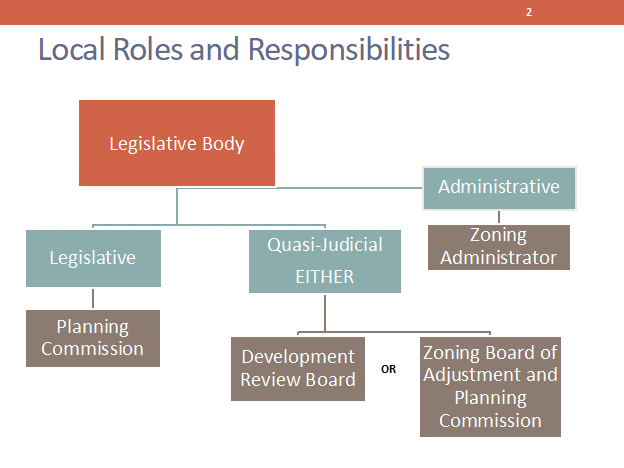Lively DRB discussion draws mostly town officials
The Selectboard’s community discussion on a potential re-organization of the Town’s Planning and Zoning processes was well attended by members of the Selectboard, Planning Commission (PC) and Zoning Board of Adjustment (ZBA), with a few “plain old” citizens attending as well. The meeting, capably moderated by Town Administrator Dean Bloch (no relation), began with a presentation by Taylor Newton, Senior Planner at Chittenden County Regional Planning Commission, outlining how the various roles and responsibilities of the various bodies differed under a PC/Development Review Board (DRB) model versus the town’s current PC/ZBA model, and the pros and cons of each. Then, an open discussion by all those attending brought many of the issues confronting the town to light.
 Mr. Newton used the familiar three branches/roles model of the US government to help clarify roles and responsibilities under the two models. In this view, the executive function is performed by the zoning administrator, the legislative (rule-making) is done by the planning commission, and the (quasi) judicial function, i.e. making decisions on specific cases and applying the rules is done by either a DRB or in the town’s current structure, by both the PC and the ZBA. That last point, dual responsibility for the quasi-judicial piece (reviewing and approving specific projects) was seen by most attending to be the biggest problem with the current system.
Mr. Newton used the familiar three branches/roles model of the US government to help clarify roles and responsibilities under the two models. In this view, the executive function is performed by the zoning administrator, the legislative (rule-making) is done by the planning commission, and the (quasi) judicial function, i.e. making decisions on specific cases and applying the rules is done by either a DRB or in the town’s current structure, by both the PC and the ZBA. That last point, dual responsibility for the quasi-judicial piece (reviewing and approving specific projects) was seen by most attending to be the biggest problem with the current system.
As further background, Taylor stated that about one half of Vermont municipalities have moved to a DRB structure with general satisfaction. Most of the municipalities maintaining the PC/ZBA structure were smaller towns of less than 2,000 population, in either the Northeast Kingdom or southern Vermont.
Much of the remaining discussion focused on Stuart Bennett’s critical question: “What problem are we trying to solve here?” Two primary problems relating to the structure were raised, as well as some related ones:
- The PC spends 85-90% of its time on “quasi-judicial” work (reviewing individual project plans) and has little time to spend on its primary function – planning.
- Citizens struggle with a confusing process (who do I see about what? …and what information do I need to include?) and what seem to be arbitrary and confusing rulings by the ZBA or PC on their projects relative to the actual rules.
A related issue which received focus was that the “town doesn’t know what it wants to become…development that does happen does not follow the town plan”, i.e. most development happens in rural areas, despite the town plan calling for more concentrated development in village areas. This was attributed in part to the lack of time spent on actual planning issues by the PC
It was agreed that moving to a DRB structure was not a “magic potion” that would solve all problems. Board member training and stability in board and administrator staffing were seen as major problems of late, as well as an overall need to streamline the rules and planning process.
Selectboard Chair Matt Krasnow reviewed the process going forward, which would include a decision by the Selectboard following more research, public input and deliberation. The final decision for any change would be made by citizens in a town meeting vote.

